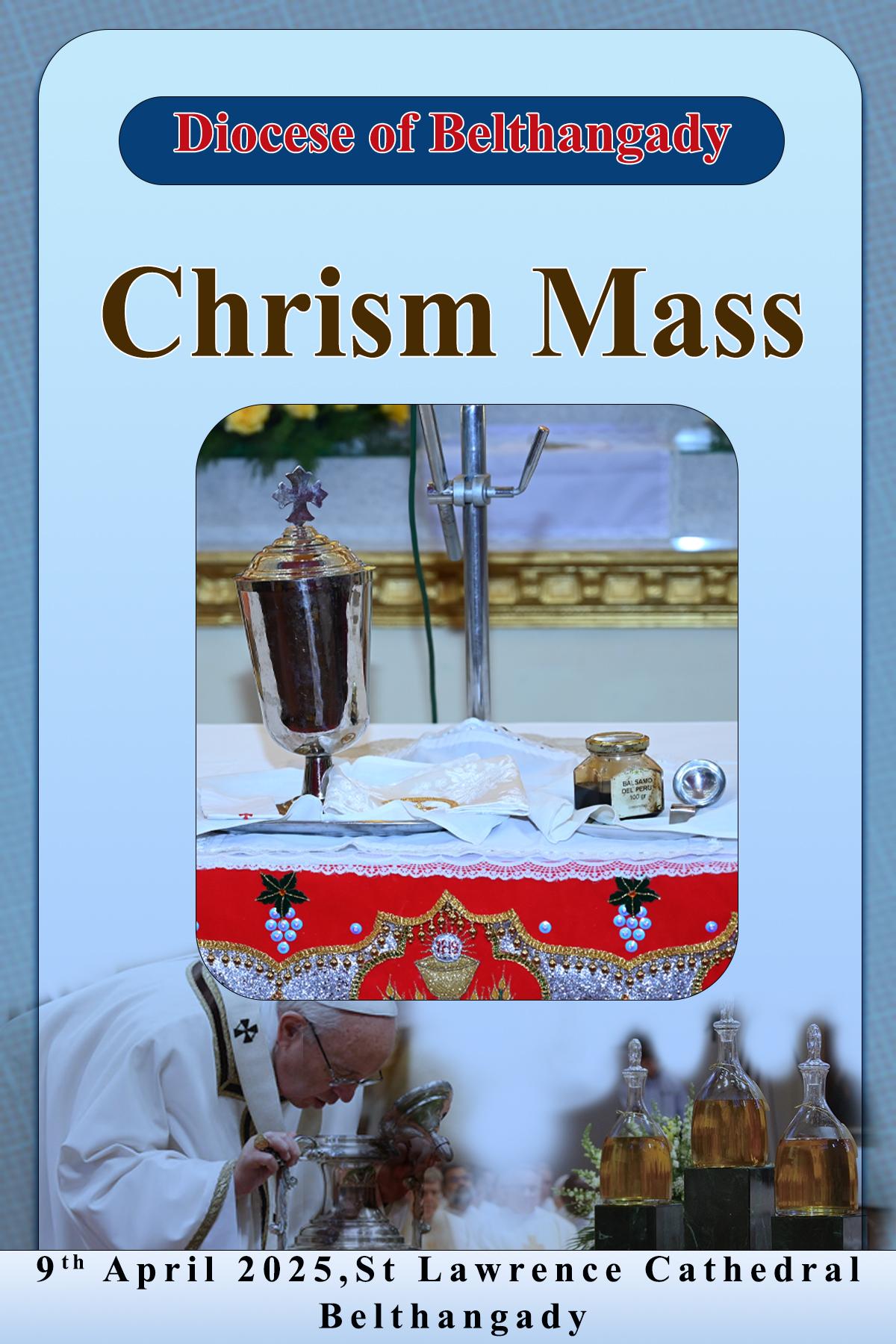News

നമ്മുടെ ബെൾതംഗഡി രൂപതയിലെ മൂറോൻ വെഞ്ചിരിപ്പ് ഏപ്രിൽ 9 ബുധനാഴ്ച സെന്റ് ലോറെൻസ് കത്തീദ്രൽ പള്ളിയിൽവെച്ച് നടത്തപ്പെടുന്നു
വിശുദ്ധ വാരത്തിൽ ആചരിക്കുന്ന വിവിധ ആരാധനക്രമങ്ങളിൽ മൂറോൻ വെഞ്ചിരിപ്പിന് സവിശേഷമായ ഒരു പ്രാധാന്യമുണ്ട്. രൂപതയുടെ കത്തീഡ്രലിൽ, പ്രാദേശിക ബിഷപ്പിന്റെ അധ്യക്ഷതയിലാണ് മൂറോൻ വെഞ്ചിരിപ്പ് കുർബാന എപ്പോഴും ആഘോഷിക്കുന്നത്. പരമ്പരാഗതമായി, ഈ കുർബാന പെസഹാ വ്യാഴാഴ്ചയാണ് നടത്തുന്നത്. എന്നിരുന്നാലും, ഇന്ത്യയിലും ലോകത്തിന്റെ മറ്റ് ഭാഗങ്ങളിലും, അജപാലന സൗകര്യാർത്ഥം, ഇത് പലപ്പോഴും നേരത്തെയുള്ള ദിവസത്തേക്ക് മാറ്റാറുണ്ട്.
മാമ്മോദീസ, സ്ഥൈര്യലേപനം, രോഗീലേപനം, പൗരോഹിത്യ പട്ട സ്വീകരണം എന്നീ കൂദാശകളിൽ ഉപയോഗിക്കുന്ന വിശുദ്ധ തൈലം -മൂറോൻ കൂദാശ ചെയ്യുന്നത് രൂപതാ മെത്രാന്റെ അധ്യക്ഷതയിൽ രൂപതയിലെ എല്ലാ വൈദികരും ഒന്നുചേർന്നാണ്. ഇതിനു ശേഷം ഓരോ ഇടവകയ്ക്കും വേണ്ടത്ര മൂറോൻ തൈലം പള്ളികളിൽ എത്തിക്കും.
2010-ൽ നടത്തിയ ഒരു പ്രഭാഷണത്തിൽ ബെനഡിക്ട് പതിനാറാമൻ മാർപ്പാപ്പ ഈ കുർബാനയുടെ ആത്മീയ സത്ത മനോഹരമായി എടുത്തുകാണിച്ചു. അദ്ദേഹം പറഞ്ഞു, “പെസഹാ വ്യാഴത്തിലെ മൂറോൻ കൂദാശ കുർബാനയിൽ ഈ വിശുദ്ധ മൂറോനാണ് ആരാധനാക്രമത്തിന്റെ കേന്ദ്രബിന്ദുവാകുന്നത് . വർഷം മുഴുവനും വേണ്ടത്ര തൈലം ഇന്നേ ദിവസം കൂദാശ ചെയ്യപ്പെടുന്നു. അങ്ങനെ അവ, സഭ ഉറപ്പുനൽകുന്ന സഭയുടെ ഐക്യത്തിന്റെ പ്രകടനമായും വർത്തിക്കുന്നു, കൂടാതെ നമ്മുടെ ആത്മാക്കളുടെ യഥാർത്ഥ 'ഇടയനും സംരക്ഷകനുമായ' ക്രിസ്തുവിലേക്ക് അവ വിരൽ ചൂണ്ടുന്നു.”
നാല് കൂദാശകളിൽ, മാമ്മോദീസയിൽ -ദൈവത്തിന്റെ ദയ നമ്മിലേക്ക് എത്തുന്നതിന്റെ അടയാളമായി വിശുദ്ധ തൈലം വർത്തിക്കുന്നു: സ്ഥൈര്യലേപനത്തിൽ പരിശുദ്ധാത്മാവിന്റെ കൂദാശയായി , തിരുപ്പട്ട സ്വീകരണത്തിന്റെ വിവിധ ഘട്ടങ്ങളിൽ, ഒടുവിൽ രോഗികളുടെ അഭിഷേകത്തിൽ എല്ലാം വിശുദ്ധ മൂറോൻ ദൈവത്തിന്റെ ഔഷധമായി പ്രവർത്തിക്കുന്നു, കഷ്ടപ്പാടുകളുടെ നിമിഷങ്ങളിൽ ശക്തിയും ആശ്വാസവും നൽകുന്നു, അതേസമയം പുനരുത്ഥാനത്തിലെ ആത്യന്തിക രോഗശാന്തിയിലേക്ക് വിരൽ ചൂണ്ടുന്നു (cf. യാക്കോബ് 5:14). മാമ്മോദീസയിൽ നമ്മുടെ ക്രിസ്തീയ ജീവിതത്തിന്റെ ആരംഭം മുതൽ നമ്മുടെ ഭൗമിക യാത്രയുടെ അവസാന നിമിഷങ്ങൾ വരെ, വിശുദ്ധ മൂറോൻ അതിന്റെ പല രൂപങ്ങളിലും ദൈവിക കൃപയുടെ അടയാളമായി മാറുന്നു.
ഈ ആരാധനക്രമത്തിന്റെ ഒരു പ്രധാന ആകർഷണം പൗരോഹിത്യ വാഗ്ദാനങ്ങളുടെ പുതുക്കലുംകൂടിയാണ്. ബിഷപ്പിന്റെയും ഒത്തുകൂടിയ വിശ്വാസികളുടെയും സാന്നിധ്യത്തിൽ, എല്ലാ പുരോഹിതന്മാരും തങ്ങളുടെ വിളിയോടുള്ള പ്രതിബദ്ധതയും ക്രിസ്തുവിനോടുള്ള വിശ്വസ്തതയും വീണ്ടും ഉറപ്പിക്കുന്നു.
മറ്റൊരു ആഴത്തിലുള്ള ബന്ധം വിശുദ്ധവാരത്തിലെ ബൈബിൾ സംഭവങ്ങളിലാണ്, അവിടെ യേശുവിന്റെ ശവസംസ്കാരത്തിനുള്ള ഒരുക്കമായി മറിയം ബെഥനിയായിൽ അഭിഷേകം ചെയ്യുന്നു. വിശുദ്ധ മൂറോൻ ഒരു തരത്തിൽ, സ്നേഹത്തിന്റെ ഈ ആംഗ്യത്തെ പ്രതിധ്വനിപ്പിക്കുകയും, പീഡാനുഭവ വാരത്തിലെ സംഭവങ്ങളിലേക്ക് വിരൽ ചൂണ്ടുകയും ചെയ്യുന്നു.
രൂപതയ്ക്കുള്ളിലെ ബന്ധങ്ങൾ ശക്തിപ്പെടുത്തുകയും മെത്രാന്റെ മാർഗനിർദേശപ്രകാരം എല്ലാ ഇടവകകളെയും ഒന്നിപ്പിക്കുകയും ചെയ്യുന്ന ഐക്യത്തിന്റെ ശക്തമായ ആഘോഷമാണ് മൂറോൻ കൂദാശ കുർബാന. തങ്ങളുടെ പ്രാദേശിക സഭയുടെ സമ്പന്നതയും അതിന്റെ ആഴത്തിലുള്ള ആത്മീയ പാരമ്പര്യങ്ങളും അനുഭവിക്കാൻ സാധാരണക്കാരെ സഹായിക്കുന്നു.
Chrism Mass will be held on 9th April Wednesday at
St Lawrence Cathedral Belthangady
Among the various liturgies observed during Holy Week, the Chrism Mass holds a unique significance. The Chrism Mass is always celebrated at the cathedral of the diocese, presided over by the local bishop. Traditionally, this Mass is held on Maundy Thursday. However, in India and other parts of the world, for pastoral convenience, it is often shifted to an earlier day.
All the priests of the diocese gather for this sacred celebration, where the bishop consecrates the holy oils used in the sacraments of Baptism, Confirmation, Anointing of the Sick, and Holy Orders. Each parish receives its annual supply of these oils during the Chrism Mass.
Pope Benedict XVI, in a homily delivered in 2010, beautifully highlighted the spiritual essence of this Mass. He said, “In the Chrism Mass on Holy Thursday, the holy oils are at the centre of the liturgical action. They are consecrated in the bishop’s cathedral for the whole year. They thus serve also as an expression of the Church’s unity, guaranteed by the episcopate, and they point to Christ, the true ‘shepherd and guardian’ of our souls.”Reflecting on the oils, Pope Benedict explained their deep spiritual symbolism and how they accompany believers on their journey of faith.
In four sacraments, oil serves as a sign of God’s benevolence reaching out to us: in Baptism, in Confirmation as the sacrament of the Holy Spirit, in the various stages of Holy Orders, and finally in the Anointing of the Sick. Here, oil acts as God’s medicine, offering strength and consolation in moments of suffering while pointing towards the ultimate healing in the resurrection (cf. Jas 5:14). From the start of our Christian life in Baptism to the final moments of our earthly journey, oil, in its many forms, becomes a sign of divine grace.
Moreover, the Chrism Mass holds a special message for priests. As Pope Benedict remarked, “The Chrism Mass, in which the sacramental sign of oil is presented as part of God’s creation, speaks directly to us who are priests: it speaks of Christ, whom God anointed as King and Priest – of him who shares his priesthood with us through ordination.”
An important highlight of this liturgy is the annual renewal of priestly promises. In the presence of the bishop and the gathered faithful, all the priests reaffirm their commitment to their vocation and their fidelity to Christ.
Another profound connection lies in the biblical events of Holy Week, where Jesus is anointed by Mary at Bethany in preparation for his burial. The Chrism Mass, in a way, echoes this gesture of love and points to the events that will unfold during the Passion.
The Chrism Mass is a powerful celebration of unity, strengthening the bonds within the diocese and uniting all parishes under the bishop's guidance. Laypeople are encouraged to attend this liturgy, to experience the richness of their local Church and its deep spiritual traditions.






